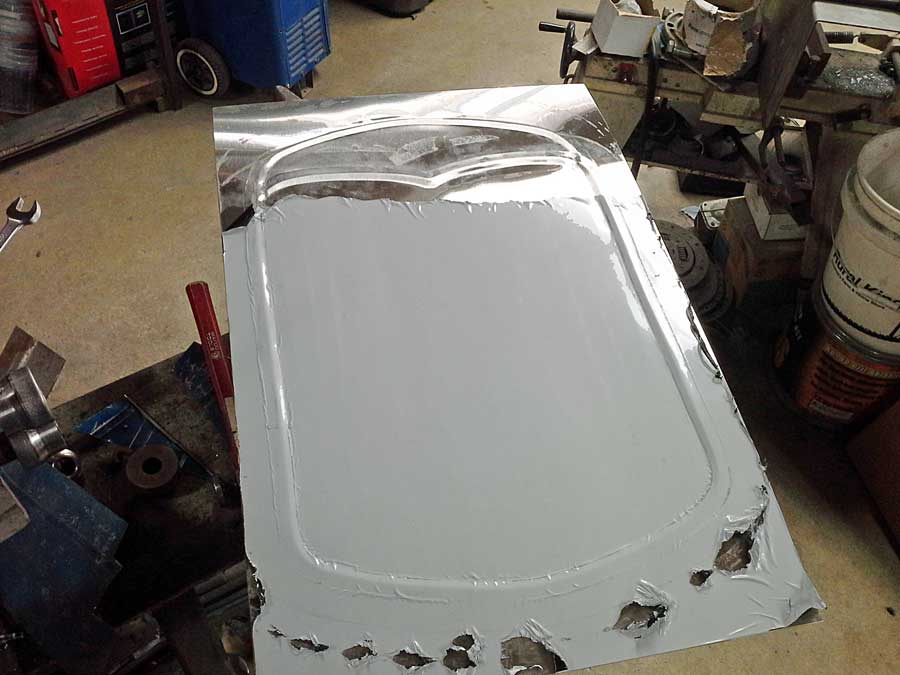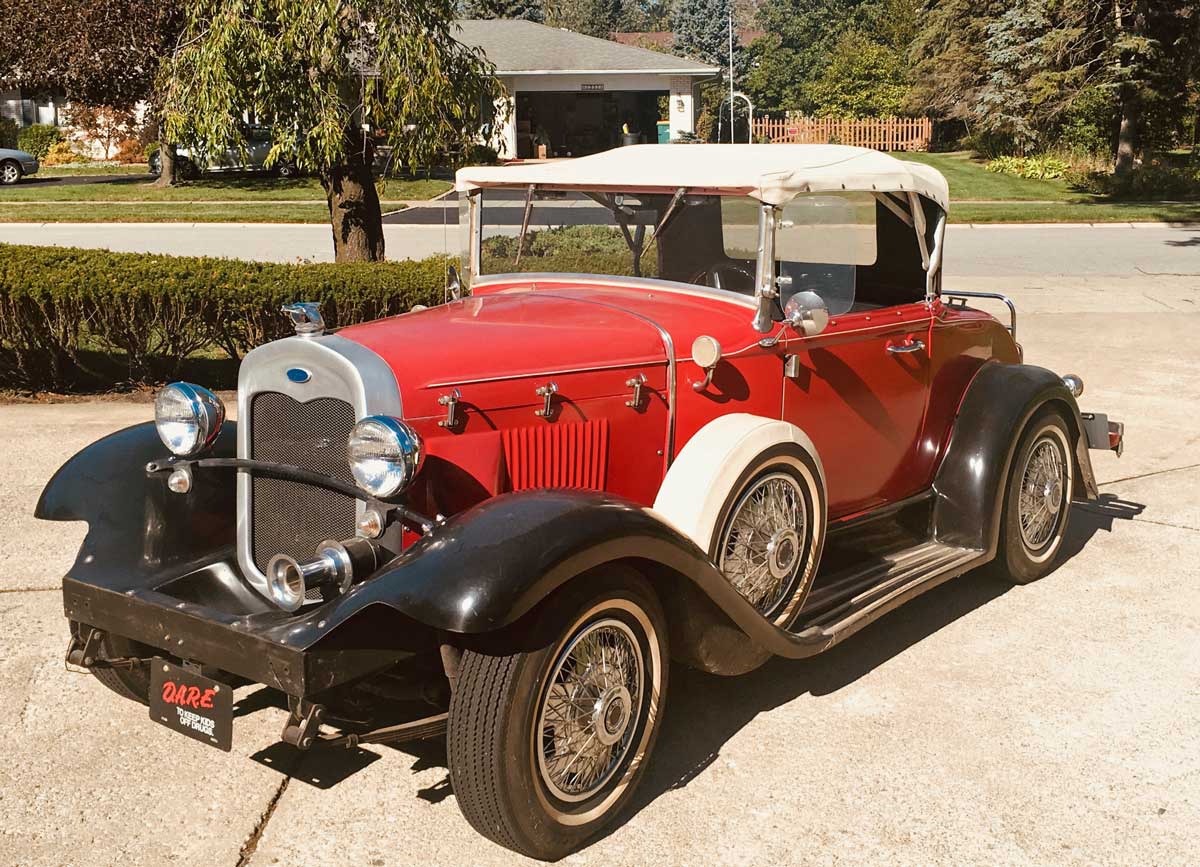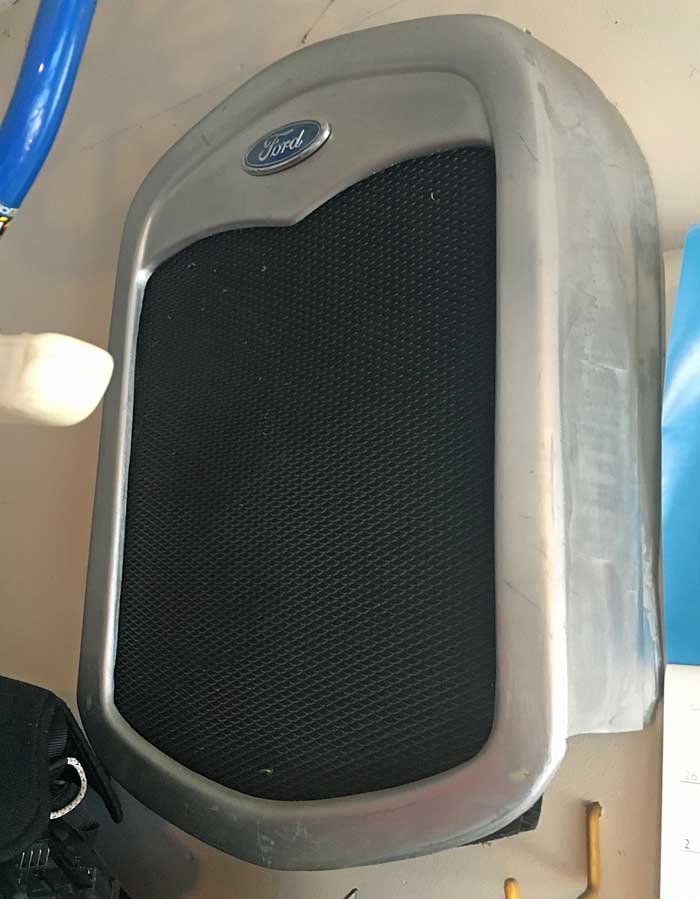| Questions come up frequently about the Glassic grill shells. In late 2016 the issue came up again, and that is when I discovered that there are fragments of info all over the Annex website, but it is not where anyone (including ME) can get at it. Here is what I have. | |
|
Stainless Grill Shell Custom Made -- you can buy one also! November 2017 Tony, Phaeton # 1452, in Northern California, is well under way to having a new, custom made shell for his Phaeton. While not the easiest project, or the cheapest, it could well end up as the ideal solution to a permanent fix for the original plastic shells that have been unable to withstand the long life they have served. Tony (the owner in the next item below) abandoned the chrome plating option in favor of Stainless Steel, and has had custom rolling dies made by a fabricator. He also has bought a sheet of stainless for the fabricator - one with enough material to cast THREE grill shells.
This shell (as I understand it) will have two parts that will be welded together and smoothed and buffed to look like one piece. Tony is willing to share this project at its cost (in
the area of $1200 per shell) which not only is non-profit, but considers
that the hard work
If you want to discuss Tony's shell, or are
considering buying one from his fabricator with him
*************************** 2017 - A Replicar owner has commissioned a special-made shell, made of steel and then chrome plated. It sounded expensive, and he had not yet (Sept, 2017) gotten a price for the project. That got me thinking again about the 1931 Ford Model A stainless steel grill shell - and the notion of cutting it down shorter, and possibly re-shaping the top curve to match the Glassic hood. When I looked for one to buy, I got a surprise. One was advertised as 30-31, but it looked a little different than I expected. A search of the web revealed this answer to the appearance question: 2017 -- The owner of car 675, having heard of the discussion about shells, presented info on his solution to the problem. He had left his original shell outside, and it vanished, so he borrowed one from another owner, made a mold, and fabricated his own FIBERGLASS shell. While not "chrome-like" in finish, it is much stronger than the original. Here are pictures of the car and the shell separately. As of 10/2017, Tom, who built this shell (and kept the mold) is willing to make more shells - in the area of $200 plus boxing and shipping costs. This shell should fit any Ford Based Glassics - what we call Generation 2 cars - but I am not sure about others. You can contact Tom at tomrogan@gmail.com if you want to discuss this radiator shell solution with him.
Radiator Shell... Remembering that just because it is on the web, does not mean that it is true, I looked at some pictures of "real" 1930 and 31 cars. The article quoted here said that they were interchangeable - meaning, the same size. The pictures below are Left: the ad I saw for 30-31 - probably a 1930, and right: a 1931. I also had understood that only the 1931 shell was made of stainless steel, but now suspect that 1930's were also stainless. Pictures of real1930s do not appear smooth on the bottom, but the tops are clearly different in appearance. In the various pictures that I saw, the bottoms are either exactly the same, or there is a tiny rolled bead on the top of the bottom face (to act as a small border for the sometimes painted insert. See the right picture below.
More Model A grill shell info In April, 2019 Rick, a long-time Model A owner and replicas fan from New Mexico, shared the following info regarding Model A shells. This info may be useful in creating a Glassic replacement for the original fiberglass or plastic shells.
From the Annexmaster: I had thought that I had seen reproduction shells for sale from Model A and hot rod parts shops, and had also thought that one could buy one shorter than normal and/or without the radiator cap hole in the top. In 2017 I have not immediately found those products on-line. The chances of a store-bought shorter shell EXACTLY fitting our needs seems remote. *********************************** CUT DOWN STAINLESS SHELL 10/2017 -- Stacey, car 341 (1st Generation Glassic, with the International drive train) reminded me of her project, completed some time ago. See pictures of her car and how the shell looks HERE This is what she said about her swap: (You) might want to refresh your memory and take a look at 341. It's a 1930 (Model A Ford) shell shortened by 2 (and I think) 1/4 inches. -- The measurement is from memory, you should verify the AMOUNT of cut-down needed (It would have been nice if the shell was) a bit wider, but it does a respectable job .
|
|
|
Glassic grill shells cannot be replaced by any "off
the shelf" reproduction product. They were uniquely made for
Glassics. By 2016 no clear-cut (no pun intended)
solution has emerged. The 1931 Model A Ford reproduction grill shells, made from Stainless Steel, seems to be the leading idea if your plastic shell is not to be salvaged. Many people have painted the original shells, others have used reproduction fiberglass 1932 Ford shells (a different look, preferred by some people). The 1931 stainless steel shell IS TOO TALL - and at the very least, needs to be shortened to fit the space (around 4 inches or so). The measurement is from memory, you should verify the AMOUNT of cut-down needed There is NOT a clear answer regarding the shape of the top, where the hood rests on the shell. The contours may not be exactly the same. I have received comments that it worked ok, and others that said that the fit was bad. That may have been for different years of Glassics / Replicars. I do not (as of 2016) have a full report from any owners who completed the project successfully. |
|
| HISTORY --(from
the History page
on the Annex.) From a long interview with Joel. who is Joel? The first radiator shells were fiberglass, gel-coated in the mold. Part of it matched the body color (known as the "frown" and the "smile" inserts), and a metallic, metal flake finish was used on the rest of the shell. Then, in the late 60’s the company changed the radiator shells to plastic. They had wanted to have the chrome look all along, but large plastic part fabrication was not that sophisticated, and the grill shell was large, with 7 square feet of surface. Getting a vacuum form for parts that size did not work well. There was an "under-cut" on the grill, so Glassic built their own machinery (oven, mold, vacuum chamber) and experimented, developing a technique to make the process work properly. Once formed, trimming became an issue since, unlike fiberglass, the plastic would tend to melt. They finally were able to trim the shells using high-speed routers. After the molding and trimming problems were solved, they had to get the shells plated. They found a plater in Georgia, and began experimenting with that aspect. It was a long, drawn-out and expensive process. Even after all of the bugs were worked out, nearly one out of each three grills was not suitable for use, and had to be thrown away. Before plating, the plastic was quite flimsy, but after plating it was much stronger, so a rack had to be built to hold the grill shell in shape until it was plated. Drilling holes in the finished product also risked damage. Since then, the processes have likely been improved. A metal radiator shell had been considered, but would have had to be custom fabricated from stainless steel, and the cost was prohibitive. At that time, Model A reproduction parts were either unavailable in quantity, and/or excessively expensive. The 1931 Model A stainless steel grill shell, although similar, is taller than the Replicar required. (It can, however, be modified to fit if a replacement is necessary). There had been an objection to the goose hood ornament by the safety people, suggesting that it was too sharp, so some cars had a ring hood ornament.
|
|
|
Car 913 - reported in 2008 on the
message board. One other thing I am going to try out is replacing the grill shell with a real, stainless, 1931 Model A unit I have had for years. It looks pretty close when I line the two up side by side, but the top of the Glassic shell is a bit different. I suspect it would not work if I was using the hood sides, but I have removed them and just use the top, so I think I may be able to flex the front of the hood enough to fit. I will take pictures of the process, and write it up, good or bad. Please be patient. No "after" report received. Why is some of this in PURPLE? -- Here is a picture of his shell - apparently he WAS able to get it to work, but no details available. |
|
|
Reference pages and items. Car 572 A cut-down and welded 1930 shell. Reported in 2020, a previous owner had changed the shell and extended the hood, and made the hood so it opened like a newer car. What info we have is on the owners page for this car. Click on the picture to see the thumbnails - the info from the current owner is there. Also, this car has smooth side panels. also longer than original, with no louvers and no bump out. Car 982. Scroll down for pic and discussion of the 1929 grill shell alternative.
Car 1147 -
- scroll down the info about this car to find the grill shell
discussion. |
|
| Alternative solutions: Car 1279 1932 fiberglass alternative, along with extensive modification to that unpleasant saucer look in front of the shell. Owner reported extensive re-shaping to the contour needed. More pictures of this project. Car 9999 1932 shell. -- This is Joel's car.who is Joel? Swapping to a 1932 grill shell or radiator shell This issue came up in June, 2005. An owner liked the look of the 32 grill shell EXAMPLE PHOTOS and asked for info on a swap. This is the answer from Joel, the builder, who is pictured with his car and the earliest Glassic.
|




 Car 341's cut down stainless steel shell
Car 341's cut down stainless steel shell